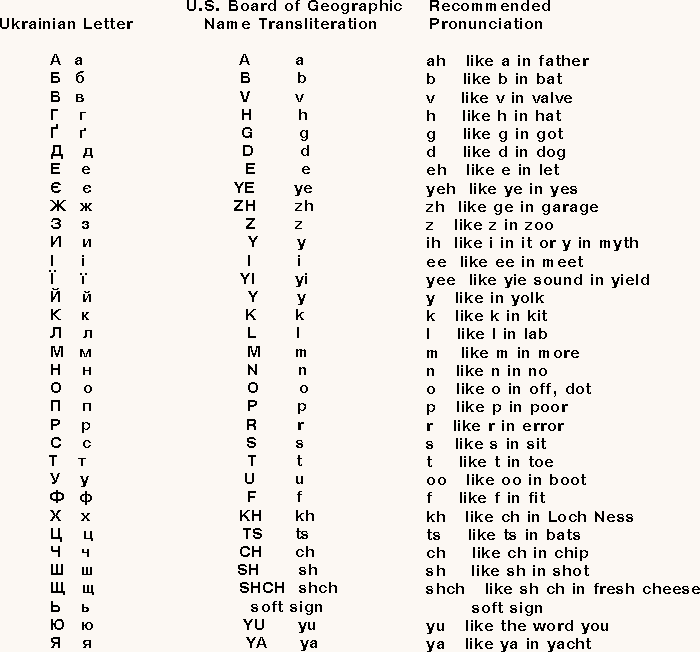





|


|
Ukrainian has a Cyrillic alphabet almost identical to some other Slavonic languages (Russian, Bulgarian). Some of its letters look exactly like those of the Latin alphabet used in English; however, most of these are pronounced differently than in English and may in fact resemble other English sounds. For instance, letter "B" in Ukrainian represents a sound similar to the English "v". Other Ukrainian letters look quite different. There are 33 letters altogether.
Please review the following transliteration table to get an idea about Ukrainian letters and their sounds.

Some important points:
1) You've seen that the English y in transliterated words (these are usually geographic and people's names) may in fact represent two quite different sounds: the one is similar to the vowel y in "myth," and the other to the consonant y in "yolk." How can you know when it's the one and when the other? Just like in English: when y is the first letter of a word or accompanies another vowel, either before or after it, it's a consonant like in "yolk," "yacht," "you," or "yield," and when y is surrounded by consonants, it is a vowel like in "myth."
2) The soft sign, unlike all other letters, does not represent an independent sound but rather affects the consonant before it, softens it. You can listen to pairs of hard and soft consonants:
(1)  |
 |
Sounds ya, yu, ye have a similar softening effect on the consonant that precedes them. It is easy to see that although represented by one letter, each of these sounds in fact combines two sounds pronounced fast one after the other. The first is the short consonant y discussed above, and the second is a regular vowel a, o, or e. The y sound is distinctly pronounced after a vowel, but if it follows a consonant, the y softens it and practically disappears itself. Listen to the following combination of sounds; there will be hard/soft pairs again.
(2)  |
 |
In transcriptions, the soft sign will be indicated with an apostrophe '. In transliteration for other purposes, since transliteration rules vary, it may or may not be used, depending on the transcriber's preferences. [Ya, yu, ye] will be transcriptions of respective Ukrainian letters after vowels; after consonants, their softening effect will be again indicated by the apostrophe ['a, 'u, 'e]. Note that we'll use the ' in transcription for study purposes only. When transliterating Ukrainian names for other purposes (e.g., documents), ya, yu, ye should be spelled so throughout.
3) For us the apostrophe will only be a transcription trick that has become customary. The Ukrainian language also uses the apostrophe, but for different purposes: it separates ya, yu, ye, yi from the preceding consonant, in which case the consonant is not softened, and the y sound in these letters is distinctly heard. You will see the apostrophe in Ukrainian originals; in transcriptions it will be indicated by a quotation mark ".
Yes, it is complicated but nonetheless important. However, once you've learned Ukrainian letters, try to refer to the transcription in this course as little as possible and listen hard to the accompanying sound files instead.
You should learn the transliteration rules because they will help you to read transcription and will also be your key to reading and writing Ukrainian people's and geographic names in the English alphabet. Slight variations in transliteration that may occur are discussed in lesson 11.
Exercise. After you have well familiarized yourself with the Ukrainian alphabet and transliteration, listen to the following passage. It is also given below in Ukrainian, as well as transcribed. Try repeating it sentence by sentence after the speaker. You will hear the line number, which will help you identify the respective lines in the text printed on your screen. Do this exercise several times, until you learn to follow the printed text and identify by ear (without referring to the English transcription) which word is being pronounced by the speaker.
For your convenience, from now on we will mark the accented (stressed) vowels in multi-syllable words in red.
(3)  |
Listen to the whole passage | (4)  |
Listen sentence by sentence and repeat |

[(1) Kyyiv stolyts'a Ukrayiny. (2) Tse naybil'she ukrayins'ke misto. (3) U n'omu meshkayut' ponad dva z polovynoyu mil'yony cholovik. (4) Kyyiv roztashovanyy na berehakh richky Dnipro. (5) Shchoroku misto vidviduyut' bahato ukrayins'kykh ta inozemnykh turystiv. (6) Tut ye, na shcho podyvytys'a. (7) Chymalo pam"yatnykh mists' nahaduyut' pro znamenni podiyi z istoriyi Kyyeva ta vsiyeyi krayiny.]
(1) Kyiv is the capital of Ukraine. (2) It is the largest Ukrainian city. (3) Over two and a half million people live there. (4) Kyiv is located on the banks of the Dnipro river. (5) Every year many Ukrainian and foreign tourists visit the city. (6) There are things to see here. (7) Quite a few memorable places remind of outstanding events in the history of Kyiv and the whole country.
This is not a word-by-word translation, so you should NOT try to learn vocabulary from this exercise. It's purpose is to solidify your ability to recognize Cyrillic letters and associate them with their sounds. That is, you're actually beginning to read in Ukrainian! On the other hand, you now have a good idea about what Ukrainian sounds like.


|


|